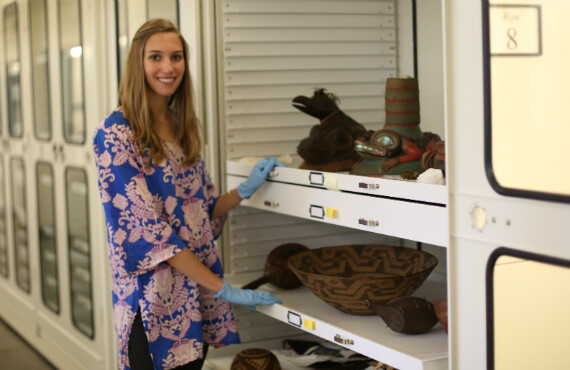Penn Museum Student Intern Solidifies Connections to Her Native American Heritage
An internship this summer at the University of Pennsylvania Museum of Archaeology and Anthropology is allowing rising junior Caroline Kee to indulge two of her passions: research and Native American culture.
As part of the internship, Kee is helping curate the upcoming exhibit Native American Voices, which is scheduled to open in March. She also is researching objects in the American collections that may come under the federal Native American Graves Protection and Repatriation Act, or NAGPRA, law. Her Summer Humanities Internship is being completed under the auspices of Penn’s Center for Undergraduate Research and Fellowships and helps her to more closely explore her Native American heritage.
“My grandmother is a tribal artist with the Choctaw nation in Oklahoma,” Kee says. “I’ve always had a connection, maybe because I’m the youngest in the family.”
During her curatorial internship for the NAV exhibit, Kee has been working on research and planning with Lucy Williams, associate curator and senior keeper of the American Collections.
For one aspect of the exhibit, Kee says tribal community members were asked to write about certain objects in the Museum collection and explain how they are traditionally used. These include textiles, such as shawls, baskets, clothing and blankets, as well as tribal bonnets, regalia, satchels and lacrosse sticks.
“The items featured are all ethnographic and archaeological objects,” she explains, “and the exhibit will have digital stories and interactive aspects.”
In the research part of her internship with NAGPRA coordinator Stacey Espenlaub, Kee is working on a request from a tribe for updated inventories and summaries for repatriation. Out of respect to the tribes and to the process of dialogue, discussions remain confidential as the Museum staff members work through the consultations.
The Penn Museum Web site provides a clue, though. In essence, NAGPRA provides a process for the return of human remains and cultural objects from museums and federal agencies to tribes and/or their lineal descendants. These include objects in the Museum collections that are from the United States that are designated as human remains, funerary objects, objects of cultural patrimony and/or sacred objects, both affiliated with tribes and culturally unaffiliated.
Museums are required to send summaries and inventories of their collections to tribes who may choose to make repatriation claims.
“I share this project with another Penn student,” Kee explains. “Returning the cultural objects is very important. It creates a long-standing relationship between the tribe and the museum.”
It’s not been all research for Kee.
“Another cool thing I got to do was to help de-install the current American exhibit with the four other section interns,” she says. “I helped take down the incredible objects that had been in those glass cases for 20 years and completed condition reports for storage. This was a very rare and amazing opportunity for hands-on work in the museum and learning the art of object handling with artifacts.
“The internship has really emphasized our getting experience in different aspects of the museum, which I enjoy very much.” she adds.
Kee, who hails from Alexandria, Va., says she was so excited to see these museum opportunities on the CURF internship list.
“CURF is awesome,” Kee says. “I knew about the Penn Museum and its American section through Natives at Penn. It was a perfect fit.”
Kee is co-chair of Natives at Penn, a cultural awareness group.
“I’ve gotten to know the Museum, but I want to know the collections better,” she says. “I want to make it familiar to others through my independent research.”
A health and societies major with a finance and management concentration and a minor in creative writing, Kee says she has a special interest in public health, how indigenous people are investing in health care, their rights and their traditional systems of medicine.
Kee has high praise for the Penn experience that has set her on this path.
She says Greenfield Intercultural Center, where Natives at Penn has its home, “is a hidden gem on campus. It fosters intercultural understanding and leadership by bringing passionate students of all different backgrounds together.”
The first time Kee was on the Penn campus, “I found Locust Walk buzzing with energy,” she recalls. “The kids all looked happy to be there. I also fell in love with the gothic architecture but mostly the energy. I got a good feeling.”
What does her future hold?
“I’ve always been interested in indigenous medicine systems and learning sustainable life-ways of people all over the world, so maybe the Peace Corps or research abroad. I’ll always allow the chance to diverge off my path.”








